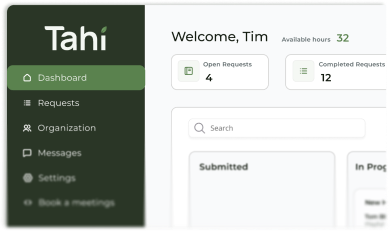Tahi Studio
Faster Websites, Greener Planet: Why High-Performance Webflow is Sustainable
Your website's performance directly impacts its carbon footprint. Discover how building faster, better Webflow sites is good for business and the planet.

The Digital Carbon Crisis You Can’t See
Let's start with a fact that might surprise you: the internet has a carbon footprint. A big one. In fact, the information and communication technology sector is responsible for 2-4% of global carbon emissions. That puts our digital world on par with the entire aviation industry. It’s a staggering thought. Every time you stream a video, send an email, or load a webpage, a chain reaction of energy consumption kicks off in data centres around the globe.
Most of this process is invisible, which makes it easy to ignore. But the impact is very real. Researchers estimate that a single page view generates about 1.76 grams of CO2 on average. That might not sound like much, but it adds up with frightening speed. A modest website with just 10,000 monthly page views will emit over 200kg of CO2 every year. For popular websites with millions of visitors, we're talking about a significant contribution to global emissions.
So, where does this pollution come from? It boils down to data and energy. When a user visits your site, their browser sends a flurry of HTTP requests to a server. That server has to think, process those requests, and send back all the necessary files, images, scripts, and stylesheets. Every single one of those requests consumes electricity, and when electricity is consumed, CO2 is generated. The more complex your website is, the more requests are needed, and the more energy is burned. It’s a direct correlation: website bloat equals pollution.
How Speed Becomes Sustainability
This is where things get interesting for us as developers and for you as a business owner. The very same principles that create a lightning-fast, high-converting website are the ones that create a more sustainable, environmentally friendly one. High performance and sustainability are two sides of the same coin.
We recently took on a client whose website was, to put it mildly, taking its time. The main landing page clocked in at a 15-second load time. You could genuinely get up, do a few stretches, and sit back down before the content appeared. Great for your posture, but absolutely terrible for business and, as it turns out, the planet. After a thorough process of stripping out bloat, optimising crucial assets, and rebuilding with a focus on efficiency, we got that load time down to 1.5 seconds. That’s a 10x improvement.
This transformation didn't just rescue their conversion rates; it dramatically cut the energy consumed with every single visit. By making the website leaner, we reduced:
- Server Load: The server has to do far less work to deliver the page, consuming less power in the data centre.
- Data Transfer: Smaller file sizes mean less data travels across the network, reducing energy consumption at every step of the journey from the server to the user's screen.
- Device-Side Processing: A simpler, cleaner page requires less processing power from the visitor's phone or computer, which also saves energy.
By focusing on page speed optimisation, we inherently made their digital presence greener. It’s a win-win. Your users get a better experience, your business sees better results, and you reduce your environmental impact. It's one of the clearest examples of where doing the right thing for your business aligns perfectly with doing the right thing for the greater good.
Practical Steps for Sustainable Webflow Development
So, how do we put this into practice? Building a sustainable website isn't about some secret, complex technique. It's about a commitment to quality and efficiency at every stage of the development process. It's about building websites the right way, something we are obsessed with in our approach to quality Webflow development.
Start with Clean, Efficient Code
The foundation of any high-performance website is its code. A site built with clean, semantic HTML and a logical class structure is inherently more efficient. It’s easier for browsers to read and render, which means faster load times. In Webflow, this means adhering to a clear framework like Client-First and avoiding the build-up of unused styles, messy div structures, and redundant code. This digital clutter, often referred to as technical debt, doesn't just make the site harder to maintain; it actively increases its energy consumption with every visit.
Master Asset Optimisation
Images, videos, and fonts are often the heaviest parts of a webpage. Getting them under control is one of the quickest ways to reduce your site's carbon footprint. This goes beyond just running an image through a compression tool. True optimisation involves:
- Choosing the Right Format: Using next-generation formats like WebP for images can offer significant file size savings over traditional JPEGs or PNGs without sacrificing quality.
- Proper Sizing: Never upload a 4000px wide image for a space that is only 500px wide. Serve images that are appropriately sized for their container on the page.
- Lazy Loading: This technique defers the loading of off-screen images and videos until the user scrolls down to them. This means less data is transferred on the initial page load, saving a huge amount of energy.
- Video Streaming: Instead of embedding large video files directly, use services like YouTube or Vimeo. This leverages their hyper-efficient streaming infrastructure and keeps your site light.
The Role of the Platform Itself
Now, it's important to be transparent here. A recent report gave Webflow a corporate sustainability score of 23, which is lower than many in its industry. This indicates that Webflow, the company, has work to do in reporting and reducing its own corporate emissions. However, this doesn't change the fact that Webflow, the tool, is an incredibly powerful platform for building lean, efficient, and therefore sustainable websites. When used by an expert team, the Webflow CMS and designer allow for a level of control that can create far more optimised sites than the plugin-heavy, often bloated alternatives common on other platforms. The power is in the hands of the developer to build responsibly.
Good for the Planet, Great for Your Business
Embracing sustainable web development isn't just an act of environmental charity; it's one of the smartest business decisions you can make. The benefits of a high-performance website create a powerful flywheel effect that boosts your bottom line.
Better Search Engine Performance
Google has been clear for years: speed is a ranking factor. With the introduction of Core Web Vitals, the technical performance of your site is more important for SEO than ever before. A fast, efficient, and lightweight website is exactly what Google wants to show its users. By optimising for sustainability, you are simultaneously optimising for search engine visibility, as detailed in our Webflow SEO blueprint. Faster, greener sites lead to better rankings and more organic traffic.
Improved Conversion Rates
The link between page speed and conversions is undeniable. Countless studies have shown that as load times increase, bounce rates skyrocket and conversion rates plummet. Users have no patience for slow websites. By providing a snappy, responsive experience, you keep users engaged and guide them more effectively towards your goals, whether that’s filling out a form, making a purchase, or signing up for a newsletter. This improved user experience directly translates to more revenue.
Stronger Brand Reputation
Consumers are increasingly making decisions based on a brand's values. Demonstrating a commitment to sustainability is no longer a niche interest; it's becoming a core part of Corporate Social Responsibility (CSR). Having a fast, low-carbon website is a tangible way to show that your business cares about its environmental impact. It's a modern, authentic way to build trust and a positive brand image with an audience that values corporate responsibility.
Reduced Hosting Costs
While often a smaller consideration, it's still a valid point. A more efficient website uses fewer server resources. This can lead to lower bandwidth usage and processing requirements, which over time can translate into reduced hosting costs. It’s another small but practical financial benefit of building a lean digital machine. If you're curious about how our efficient development practices impact long-term value, you can explore our subscription plans.
Making Quality the New Standard
The conversation around web development needs to evolve. For too long, performance has been treated as a feature or an afterthought. The evidence is now clear: building high-performance, quality websites is not just a technical best practice. It is a fundamental responsibility for any business operating online.
Sustainable web design is no longer an optional extra. It's the inevitable result of a commitment to quality. When we build websites, we build them to be fast, accessible, and efficient because that provides the best experience for the user and the best results for the business. The wonderful, crucial side effect is that this method is also inherently better for our planet.
The path forward is clear. We must stop seeing websites as just digital brochures and start seeing them as active participants in our global energy consumption. By choosing quality, demanding performance, and partnering with developers who prioritise efficiency, we can collectively reduce the internet's carbon footprint, one fast-loading website at a time.
Is your website working as hard for the planet as it is for your business? A slow site could be costing you more than just customers. Let's find out. We offer a free, no-obligation site audit to analyse your performance and identify the key areas that could improve both your conversion rates and your carbon footprint.







